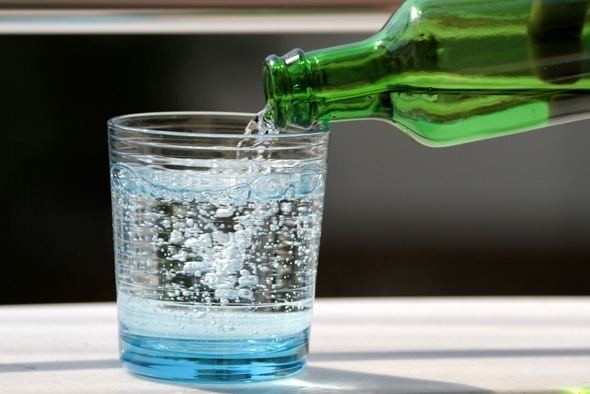 | ||
Similar Water, Tonic water, Sugar, Lemonade, Mojito | ||
Is carbonated water bad for you 60 second answer
Carbonated water (also known as club soda, soda water, sparkling water, seltzer water, "bubbly water" or fizzy water) is water into which carbon dioxide gas under pressure has been dissolved. Some of these have additives, such as sodium chloride, sodium bicarbonate or similar, but seltzer water is almost always composed of water and carbon dioxide with no other additives. This process, known as carbonation, is a process that causes the water to become effervescent. Most carbonated water is sold in ready to drink bottles as mineral water and carbonated beverages such as soft drinks. However, it is rather easy to prepare at home with soda makers.
Contents
- Is carbonated water bad for you 60 second answer
- Is carbonated water bad for you
- Carbonation
- Health effects
- Chemistry and physics
- History
- Etymology
- Social popularity decline and renaissance
- Soda siphons
- Gasogene
- Codd neck bottles
- Soda makers
- Commercial
- Carbonated beverages
- Alcoholic beverages
- Cooking
- Stain remover
- References
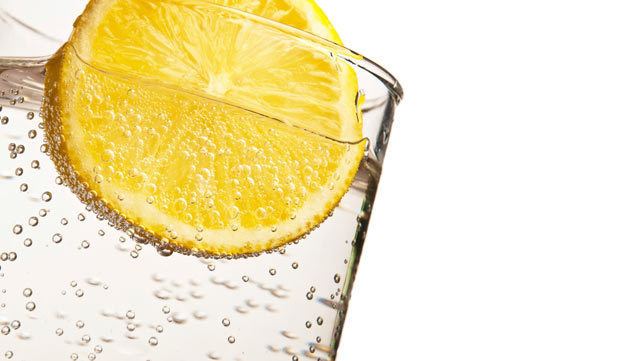
Is carbonated water bad for you
Carbonation

Whether homemade or store-bought, soda water may be identical to plain carbonated water or it may contain a small amount of table salt, sodium citrate, sodium bicarbonate, potassium bicarbonate, potassium citrate, potassium sulfate, or disodium phosphate, depending on the bottler. These additives are often included to emulate the slightly salty taste soda water developed years ago from first using them as preservatives. Naturally occurring processes also produce effervescent mineral water similar to carbonated water in artesian wells, such as in Mihalkovo in the Bulgarian Rhodope Mountains, in Medžitlija in Macedonia, or most notably in Selters in the German Taunus mountains.
Health effects
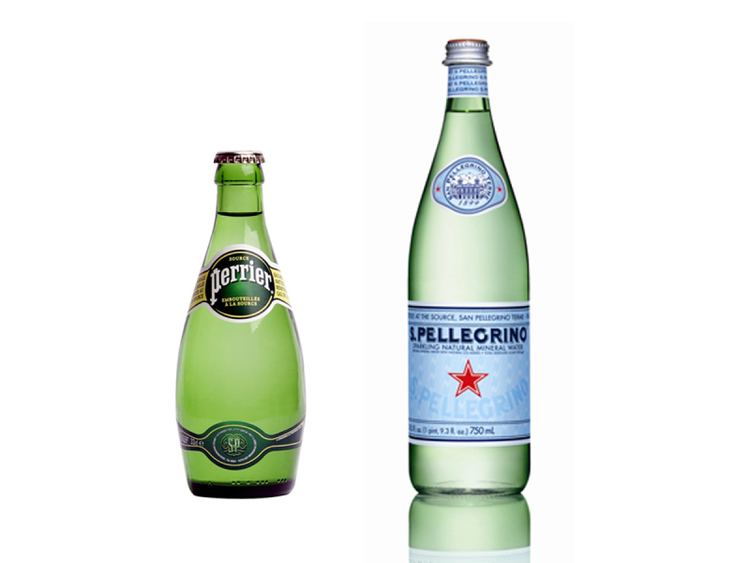
By itself, carbonated water appears to have little impact on health. While carbonated water is somewhat acidic, this acidity is quickly neutralized by saliva.

Carbonated water may increase irritable bowel syndrome symptoms of bloating and gas due to the release of carbon dioxide in the digestive tract. It does not appear to have an effect on gastro-oesophageal reflux disease. There is tentative evidence that carbonated water may help with constipation among people who have had a stroke. Some carbonated waters have added sodium, so they may be an issue for those on low-sodium diets.

Typical carbonated soft drinks such as colas do have health risks. Carbonated colas have a correlation with slightly decreased bone density in older women. Soft drinks are about 100 times more erosive to teeth than plain carbonated water.
Chemistry and physics
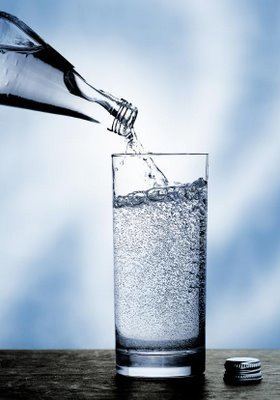
Carbon dioxide gas dissolved in water at a low concentration (0.2–1.0%) creates carbonic acid (H2CO3) according to the following reaction:
H2O(l) + CO2(g) ⇌ H2CO3(aq)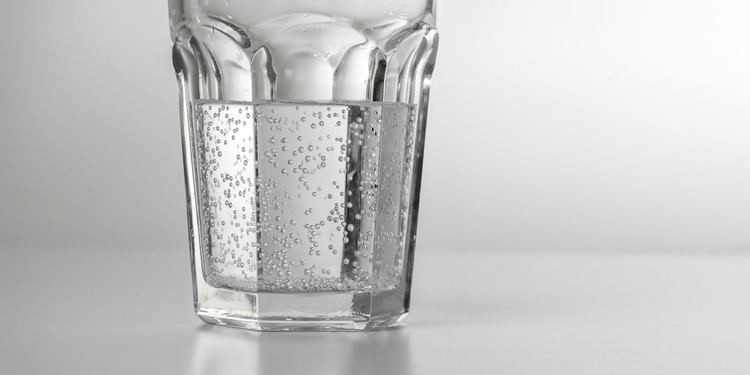
The acid gives carbonated water a slightly tart flavor. The pH level between 3 and 4 is approximately in between apple juice and orange juice in acidity, but much less acidic than the acid in the stomach. The human body robustly maintains pH equilibrium via acid–base homeostasis and will not be affected by consumption of plain carbonated water. If an alkaline salt, such as sodium bicarbonate, potassium bicarbonate, or potassium citrate is added to the water, its acidity is reduced.
The amount of a gas like carbon dioxide that can be dissolved in water is described by Henry's Law. Water is chilled, optimally to just above freezing, in order to permit the maximum amount of carbon dioxide to dissolve in it. Higher gas pressure and lower temperature cause more gas to dissolve in the liquid. When the temperature is raised or the pressure is reduced (as happens when a container of carbonated water is opened), carbon dioxide escapes from the solution, in the form of bubbles. This is known as effervescence.
History
Many alcoholic drinks, such as beer, wine and champagne, were carbonated through the fermentation process for centuries. In 1662 Christopher Merret was creating 'sparkling wine'. In 1750 the Frenchman Gabriel François Venel produced artificial carbonated water for the first time. It is thought that William Brownrigg and Henry Cavendish also infused water with carbon dioxide around this time. In 1767, Joseph Priestley discovered a method of infusing water with carbon dioxide when he suspended a bowl of water above a beer vat at a local brewery in Leeds, England. The air blanketing the fermenting beer—called 'fixed air'—was known to kill mice suspended in it. Priestley found water thus treated had a pleasant taste, and he offered it to friends as a cool, refreshing drink. In 1772, Priestley published a paper titled Impregnating Water with Fixed Air in which he describes dripping "oil of vitriol" (sulfuric acid) onto chalk to produce carbon dioxide gas, and encouraging the gas to dissolve into an agitated bowl of water. Priestley referred to his invention of soda water as being his "happiest" discovery.
In the late eighteenth century, J. J. Schweppe (1740–1821) developed a process to manufacture carbonated mineral water, based on the process discovered by Priestley, founding the Schweppes Company in Geneva in 1783. In 1792 he moved to London to develop the business there. In 1799 Augustine Thwaites founded Thwaites' Soda Water in Dublin. A London Globe article claims that this company was the first to patent and sell "Soda Water" under that name.
Modern carbonated water is made by passing pressurized carbon dioxide through water. The pressure increases the solubility and allows more carbon dioxide to dissolve than would be possible under standard atmospheric pressure. When the bottle is opened, the pressure is released, allowing the gas to come out of the solution, forming the characteristic bubbles.
Etymology
In the United States, carbonated water was known as soda water until World War II, due to the sodium salts it contained. These were added as flavoring and acidity regulators with the intent of mimicking the taste of natural mineral water. During the Great Depression, it was sometimes called "two cents plain", a reference to its being the cheapest drink at soda fountains (i.e. without the addition of three cents-worth of flavored syrup).
In the 1950s, terms such as sparkling water and seltzer water gained favor. The term seltzer water is a genericized trademark that derives from the German town Selters, which is renowned for its mineral springs. Naturally carbonated water, Selters, has been commercially bottled and shipped from this town since the 18th century or earlier. Generally, seltzer water has no added sodium salts, while club soda still retains some of the sodium salts that once were used. The term "Seltzer water" is virtually unknown in Britain and most Commonwealth countries, although Australians of a certain age remember Selza Saline powder in metal tins with lids which had to be opened for each use with the back of a spoon, sold during the 1950s.
In many parts of the US, soda has come to mean any type of sweetened, carbonated soft drink.
In the United Kingdom and Canada today, drink mixers sold as soda water or club soda contain bicarbonate of soda, which gives them a specific flavour and differentiates them from carbonated water. It is popularly used for drinks such as whisky and soda and Campari soda.
Social popularity, decline, and renaissance
Carbonated water changed the way people drank. Instead of drinking liquor straight/neat (without a mixer), soda water and carbonated soft drinks helped dilute alcohol, and made having a drink more socially acceptable. Whisky and sodas can be seen in many British TV series and films from the 1960s and earlier and the soda siphon is ubiquitous in many movies made before 1970. Only a small amount of soda water is added; a 'splash', and 'Scotch and a splash' was a common bar order. Whisky and soda was commonly drunk without ice in the UK.
Social drinking changed with the counter-culture movement of the 1970s and the arrival of new bottled and canned beverages in the 1980s, and soda water has declined in popularity. Soda siphons are still bought by the more traditional bar trade and are available at the bar in many upmarket establishments, but in the UK there are now only two wholesalers of soda-water in traditional glass siphons, and an estimated market of around 120,000 siphons per year (2009). Worldwide, preferences are for beverages in recyclable plastic containers.
Home soda siphons and soda water are enjoying a renaissance in the 21st century as retro items become fashionable. Contemporary soda siphons are commonly made of aluminum, although glass and stainless steel siphons are available. The valve-heads of today are made of plastic, with metal valves, and replaceable o-ring seals. Older siphons are in demand on on-line auction sites. Carbonated water, without the acidity regulating addition of soda, is currently seen as fashionable although home production (see above) is mainly eschewed in favor of commercial products.
Soda siphons
The soda siphon, or seltzer bottle — a glass or metal pressure vessel with a release valve and spout for dispensing pressurized soda water — was a common sight in bars and in early- to mid-20th century homes where it became a symbol of middle-class affluence.
The gas pressure in a siphon drives soda water up through a tube inside the siphon when a valve lever at the top is depressed. Commercial soda siphons came pre-charged with water and gas, and were returned to the retailer for exchange when empty. A deposit scheme ensured they were not otherwise thrown away.
Home soda siphons can carbonate flat water through the use of a small disposable steel bulb containing carbon dioxide. The bulb is pressed into the valve assembly at the top of the siphon, the gas injected, then the bulb withdrawn. Soda water made in this way tends not to be as carbonated as commercial soda water because water from the refrigerator is not chilled as much as possible, and the pressure of carbon dioxide is limited to that available from the cartridge rather than the high-pressure pumps in a commercial carbonation plant.
Gasogene
The gasogene (or gazogene, or seltzogene) is a late Victorian device for producing carbonated water. It consists of two linked glass globes: the lower contained water or other drink to be made sparkling, the upper a mixture of tartaric acid and sodium bicarbonate that reacts to produce carbon dioxide. The produced gas pushes the liquid in the lower container up a tube and out of the device. The globes are surrounded by a wicker or wire protective mesh, as they have a tendency to explode.
Codd-neck bottles
In 1872, British soft drink maker Hiram Codd of Camberwell, London, designed and patented the Codd-neck bottle, designed specifically for carbonated drinks. The Codd-neck bottle encloses a marble and a rubber washer/gasket in the neck. The bottles were filled upside down, and pressure of the gas in the bottle forced the marble against the washer, sealing in the carbonation. The bottle was pinched into a special shape to provide a chamber into which the marble was pushed to open the bottle. This prevented the marble from blocking the neck as the drink was poured.
Soon after its introduction, the bottle became extremely popular with the soft drink and brewing industries mainly in Europe, Asia and Australasia, though some alcohol drinkers disdained the use of the bottle. One etymology of the term codswallop originates from beer sold in Codd bottles, though this is generally dismissed as a folk etymology.
The bottles were regularly produced for many decades, but gradually declined in usage. Since children smashed the bottles to retrieve the marbles, they are relatively rare and have become collector items, particularly in the UK. They could be found at retail shops and restaurants in many parts of the world until recently. Due to the risk of explosion and injuries from fragmented glass pieces, use of this type of bottle is no longer encouraged in most countries. The Codd-neck design is still used for the Japanese soft drink Ramune and in the Indian drink called Banta.
Soda makers
Soda makers or soda carbonators are appliances that carbonate water with multiple-use carbon dioxide canisters. Soda makers may reach a higher level of carbonation than home soda siphons. A variety of systems are produced by manufacturers and hobbyists. The commercial units may be sold with concentrated syrup for making flavored soft drinks.
One major producer of soda carbonators is SodaStream. Their products were popular during the 1970s and 1980s in the United Kingdom, and are associated with nostalgia for that period and have experienced a comeback since.
Commercial
The process of dissolving carbon dioxide in water is called carbonation. Commercial soda water in siphons is made by chilling filtered plain water to 8 °C (46 °F) or below, optionally adding a sodium or potassium based alkaline compound such as sodium bicarbonate to reduce acidity, and then pressurizing the water with carbon dioxide. The gas dissolves in the water, and a top-off fill of carbon dioxide is added to pressurize the siphon to approximately 120 pounds per square inch (830 kPa), some 30 to 40 psi (210–280 kPa) higher than is present in fermenting champagne bottles.
In many modern restaurants and drinking establishments, soda water is manufactured on-site using devices known as carbonators. Carbonators use mechanical pumps to pump water into a pressurized chamber where it is combined with CO
2 from pressurized tanks at approximately 100 psi (690 kPa). The pressurized, carbonated water then flows to taps or to mixing heads where it is mixed with flavorings as it is dispensed.
Carbonated beverages
Plain carbonated water is often consumed as an alternative to soft drinks. However, a soft drink is a beverage that typically contains carbonated water, a sweetener and a flavoring. Flavored carbonated water is also commercially available like cola. Carbonated water is often consumed mixed with fruit juice. It differs from sodas in that it contains flavors (usually sour fruit flavors such as lemon, lime, cherry, orange, or raspberry) and usually a sweetener. Many people cut up fresh fruit and put in their carbonated water.
Alcoholic beverages
Carbonated water is a diluent mixed with alcoholic beverages where it is used to top-off the drink and provide a degree of 'fizz'.
Adding soda water to 'short' drinks such as spirits dilutes them and makes them 'long' not to be confused with long drinks such as those made with vermouth. Carbonated water also works well in short drinks made with whiskey, brandy, and Campari. Soda water may be used to dilute drinks based on cordials such as orange squash. Soda water is a necessary ingredient in many cocktails, such as whisky and soda or Campari and soda.
Cooking
Carbonated water is increasingly popular in cooking to provide a lighter texture to doughs and batters as compared to regular water. Kevin Ryan, a food scientist at the University of Illinois at Urbana–Champaign, says the effervescent bubbles when mixed with dough provide the light texture. Pockets of carbon dioxide gas are introduced into the dough and further expand when cooking.
Stain remover
The popular belief that club soda is a good remover of clothing stains, particularly those of red wine, is based on hearsay and anecdotal evidence. There is no underlying chemical reason why club soda would be superior to plain water in stain removal.
